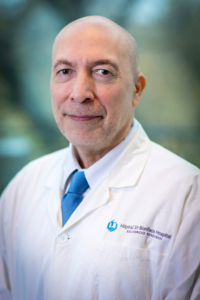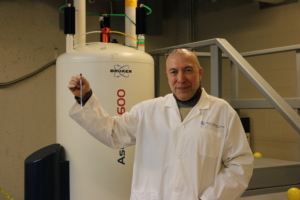Don’t like finishing your vegetables at dinner? St. Boniface Hospital researcher Dr. Michel Aliani can tell you why you should.
Aliani is Principal Investigator, Nutritional Metabolomics Research in the Division of Neurodegenerative Disorders (DND) at the Hospital’s Albrechtsen Research Centre.
Yellow pea flour alone contains at least 3,000 to 4,000 different compounds that researchers can measure, said Aliani. (Anything with a chemical formula is a compound: amino acids, sugars, etc.)

In the lab at St. Boniface Hospital, Aliani and his team are putting these flours and pan-breads in what researchers call a system and trying to break them down in vitro, as if they were in a stomach. In doing so, they can identify everything that’s coming from the system.
“It’s possible to monitor thousands of compounds,” said Aliani, who is the research project lead. “How and where are they going to push a digestive system? Is it just to get energy into the body, or other reasons? By monitoring all that, researchers can see what else was pushed through digestion.”
Pulses are a great source of non-animal protein, are nutritious, and researchers like Aliani know they can help many patients control diabetes, hypertension, and obesity. While our country is one of the largest producers of pulse crops in the world, Canadian families tend not to eat a lot of peas (and other pulses) largely because of their perceived unpleasant “beany” or “grassy” flavour.
Yellow peas have “good” fatty acids – Omega-3 fatty acids, for example – upon which enzymes work, creating volatile organic compounds that are responsible for the beany flavour many Canadians don’t like. A heat treatment process, patented by Revtech Process Systems in France, allows researchers to control the moisture levels in peas. The process eliminates the enzymes that are responsible for the unpleasant flavour in yellow peas.

“The healthier the food we consume, the healthier we are as a society. You can keep telling people, ‘It’s very good for you,’ but food is something from which people want pleasure. Not just to eat it because it’s healthy.”
St. Boniface Hospital Research is made up of the Albrechtsen Research Centre, the I. H. Asper Institute, and the Dr. Andrei Sakharov MRI Centre. Our Research program is home to world-renowned groups like the Institute of Cardiovascular Sciences (ICS), the Division of Neurodegenerative Disorders (DND), the Canadian Centre for Agri-Food Research in Health and Medicine (CCARM), and so many more. Together, they create and maintain a tradition of excellence in research, education, and care.


